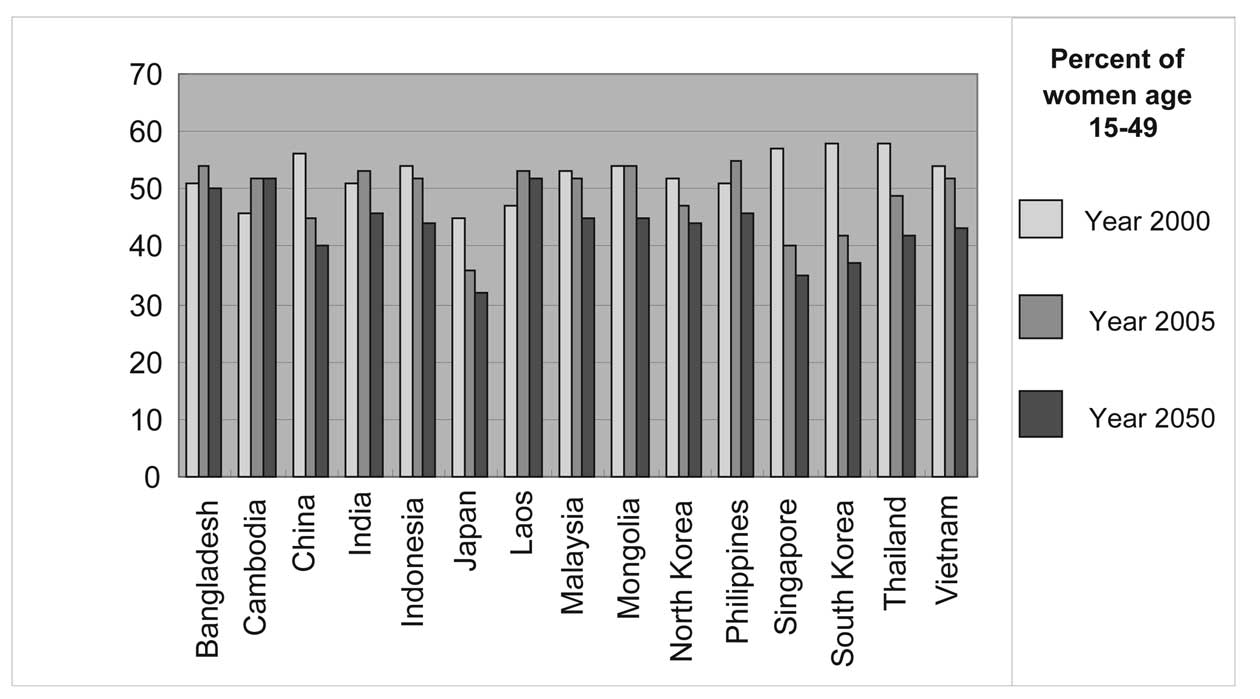a reduction in family size. Along with improvements in the population gender ratio and the potential for increased matriarchal households and stress on family labor, these trends present a mixed picture for agriculture (United Nations, 2001). The region demonstrates a decreasing trend in agricultural employment rates with increasing importance of non-farm work for income security.
Over the past half-century, women's participation in the labor force has increased steadily in many Asian countries, particularly in the rapidly growing economies of East and Southeast Asia. In 1999, half or more of women in the age groups 15-64 were employed in all sectors, including agriculture, in nine Asian countries (ADB, 2001a) (Figure 4-2).
The female contribution to the overall economy is high throughout the ESAP region, particularly in terms of labor input into agriculture. Bangladesh, Bhutan, Cambodia, China, India, Myanmar, Nepal, Pakistan and Viet Nam have particularly high percentages of women employed in the agricultural sector, with estimates ranging between 60 and 98%. Indeed, in most Asian countries the number of women employed in agriculture as a percentage of the EAP is higher than that of men (Garcia et al., 2006). Female members from farming households will play increasingly important roles as key agents of change by serving as extension agents to other women farmers and laborers. Experiences in Bangladesh demonstrated that including women in training in specific technologies in which they were actively engaged and in the overall production system contributed to more effective decision-making. Several successful women-led projects included promotion of post-harvest and storage technologies and video-centered learning. Rural women will become the direct recipients of village level training courses which deal with knowledge-intensive agricultural technologies (crops, livestock, fisheries, agroforestry) crop and livestock (Paris et al., 2005).
4.2.1.5 Rural-urban and inter-regional migration
Rural to urban migration still dominates migration flows in most Asian countries because of the high proportion of |
|
the population living in rural areas (DESA, 2006). According to the 2005 Revision of World Urbanization Prospect, the global proportion of urban population increased from 13% in 1900 to 49% in 2005 and is expected to reach 60%, or 4.9 billion people, by 2030. While urbanization continues to be on the rise, rural populations are still significant and are currently growing. However, a gradual decline in rural populations is expected to commence in 2019, reaching slightly less than the current 3.3 billion by 2030. In 2005, 71% of all rural dwellers lived in Asia, primarily in India, China, Indonesia and Bangladesh. At the same time, the Asian urban population has reached over 1.5 billion. This is projected to rise to over 2.6 billion by 2030 (Figure 4-1).
Two other estimates show slightly different trends. Between 2005 and 2030 the Asian urban population is expected to rise by 2.12% annually (DESA, 2006). At the same time, rural populations are anticipated to decline by 0.2% annually. There are likely to be 2.2 billion rural Asians by the year 2020 and this rural population will have much lower access to health and education, and a lower level of general well-being (ADB, 2001b).
Since 1950 countries such as Australia, China, Fiji, Indonesia, Japan, Korea DPR, Republic of Korea and the Philippines have recorded negative population growth in rural areas. Yet many developing countries in the region still have a larger percentage of rural population compared to urban population. In particular, countries that depend heavily on agriculture as economic drivers register less than 30% of their total population as urban, e.g., Bangladesh, Bhutan, Cambodia, India, Lao PDR, Nepal, Papua New Guinea, Sri Lanka, Samoa, Solomon Islands, Vanuatu and Viet Nam. For China, the urban population is projected to reach around 60.5% of the total population and hence exceed rural population by 2030 (UNDP, 2003).
Urbanization is likely to pose a major labor market concern as well as environmental concerns (Dyson et al., 2004). Countries such as China, Thailand, Sri Lanka and Malaysia |
